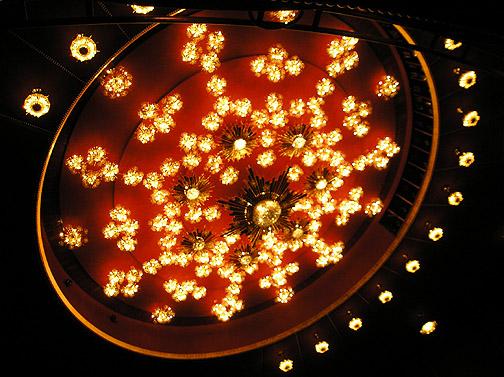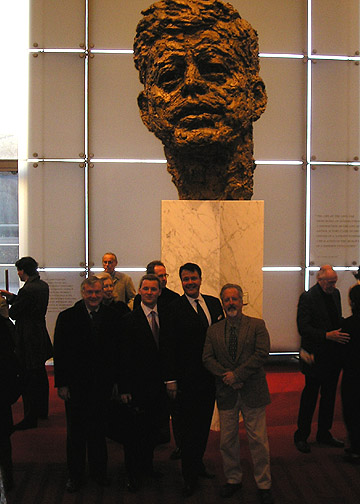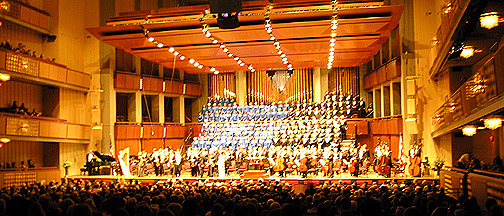
By any account, sitting through a five hour long opera is a test of strength and determination, but it is all the more so an ordeal and a test of utter will when the opera is such an intensely dramatic and emotional event as the 1882 piece which German composer Richard Wagner (REE-kard VAG-nair) called a "Bühnenweihfestspiel" (festival play for the consecration of the stage), his opera Parsifal.
And yet, by sitting through the entire opera, by experiencing the totality of the pathos of the performers from begining to end, we journey with the performers and attain our own catharsis and spiritual redemption.
Thus we were enlightened Tuesday night when four of us soujourning knights ventured forth to the Opera House at the John F. Kennedy Center for the Performing Arts in Washington, D.C., to hear the Kirov Opera and Orchestra of the Mariinsky Theater in St. Petersberg, Russia, present Parsifal. Parsifal is a work loosely based on the Arthurian legend of the knight Percival and his quest for the Holy Grail, yet intermixed with both Christian and Buddhist allegory. Wagner's story focuses on the Knights of the Grail, who have in their possession the Holy Grail—the chalice used by the Christian god Jesus at His "Last Supper"—and who have recently lost to the forces of darkness the Holy Spear—the spear which had been used to pierce the side of Jesus following His crucifixion. Parsifal, an innocent, meets the knights and takes up the quest of finding and returning the Holy Spear.
 Because of the length of the opera, there was an unusually early curtain time at 6 p.m. Audiences for these sorts of performances are unique; only the truly devoted operaphiles can brave the long, intense Wagnerian experience, so the "socialite" opera goers were nowhere to be seen. Since Svet and I had four tickets for the evening, we invited a couple of Wagner lovers to join us, a curator from the Library of Congress and a retired executive from the World Bank. To the left is a picture of us in the Grand Foyer, just outside the Opera House by the famous eight-feet-tall bust of Kennedy by sculptor Robert Berks.
Because of the length of the opera, there was an unusually early curtain time at 6 p.m. Audiences for these sorts of performances are unique; only the truly devoted operaphiles can brave the long, intense Wagnerian experience, so the "socialite" opera goers were nowhere to be seen. Since Svet and I had four tickets for the evening, we invited a couple of Wagner lovers to join us, a curator from the Library of Congress and a retired executive from the World Bank. To the left is a picture of us in the Grand Foyer, just outside the Opera House by the famous eight-feet-tall bust of Kennedy by sculptor Robert Berks.One of the great challenges of experiencing Parsifal is making it through the over two hour-long first act. Wagner's operas are infamous for their lengthy periods of expository dialogue and the seemingly endless and emotionally draining orchestral interludes between vocal lines, and the first act of Parsifal is a sterling example of those problems. The rewards, though, come at the end of the act when the Knights of the Grail conduct their ceremony for the adoration of the Holy Grail and their almost pagan-like communion service. In the midst of a sparkling and dazzling contemporary set, some four dozen knights sang while an angelic (aside from a few bad notes in the soft, high sections) women's choir located somewhere in the rafters of the house, perhaps in some of the light booths, served as Greek chorus, providing an ethereal and spine-shivvering moral commentary to the action on stage.
The lengthy first act provided us with some interesting logistical problems, namely, how were we going to eat dinner when we were at the Opera House for nearly six hours. That long first act made a big meal prior to the show impractical. When I've gone to long Wagner performances at the Metropolitan Opera in New York, they've had an extended first intermission which allowed patrons to have a quick two course meal in one of the house restaurants and then return in the second intermission for the dessert course, but the Kennedy Center sticks with standard twenty-minute intermissions that barely allow people to get through the cocktail bar line before they start ringing the chimes. I solved the problem by smuggling food into the Kennedy Center. I fixed us four little box lunches with a croissant stuffed with spinach and feta cheese, some slices of Maytag blue cheese with sesame-garlic flatbread, sliced kiwi fruit, roasted cashews, and little miniature cannolis, plus little white damask cocktail napkins (I hate paper!), all stashed away in Svet's big black briefcase. As soon as we got out of the house, we went out onto the terrace overlooking the river for our clandestine little repast.
We saw lots of people we knew during the interval, including the rather bleary-eyed Austrian Ambassador. The monsignor pastor of my little Catholic parish by my house was there with some other priest friend of his, and when they came over to chat, I offerred and they split and ate my cannolo (I sure hope I didn't food poison anyone, since I never got to taste one!). There was also a funny moment as the chimes rang and a man who looked like a lamb being led to the slaughter was told by his wife, "Don't worry, honey. Things pick up in the second and third acts."
And pick up they did. The second act is a vocal tour de force, and soprano Larissa Gogolevskaya as Kundry was absolutely spectacular. Character bass Nikolai Putilin as Klingsor was striking in his white makeup, furred and billowing robe, and enormous, swooping, black and silver wig. One of the odd things about Wagner's writing is that the title role in this opera is a rather tame and restrained part; tenor Oleg Balashov nevertheless acquitted himself quite serviceably as Parsifal. And, in both the first and third acts, Gennady Bezzubenkov as Gurnemanz had such a resonant and deep "Russian bass" voice I could have sworn that when he was singing directly at me he was amplified.
The Mariinsky Theater Orchestra was led by general director Valery Gergiev, a renowned conductor in Russia, and he certainly seemed to have his fans and cheering section here in Washington. He kept the orchestra together on a steady, even path to get through the music without allowing it to bog down and drag; he also did an excellent job in controlling the orchestra's playing volume so as not to cover up the singers while still having some thrilling, big brass fortissimos.
There is one remaining performance of Parsifal on Sunday afternoon. For the confirmed opera or Wagner devotee, this production is well worth a look.

